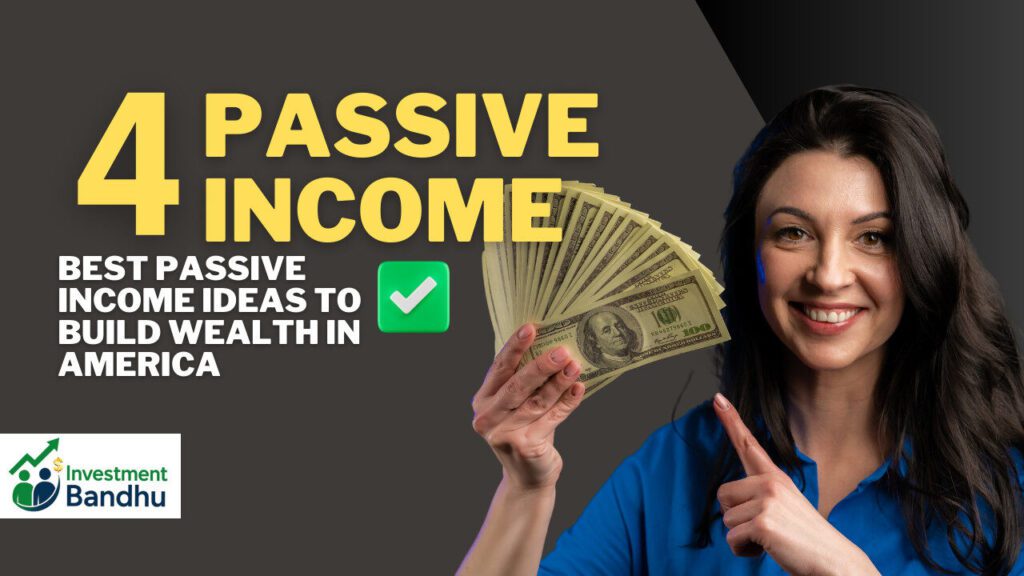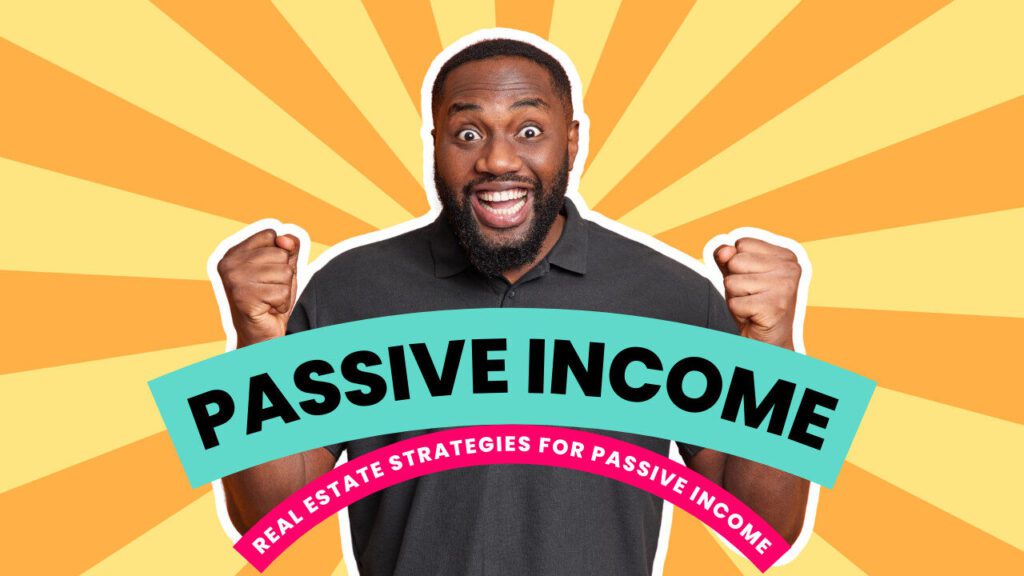Understanding Passive Income and Why It Matters

What is Passive Income?
Passive income is money you earn without actively trading your time for every dollar. Unlike a traditional job where you work hourly or earn a salary, passive income flows in with less daily effort once the system, investment, or asset is set up.
Think of it like planting seeds in a garden. At first, you water, till, and nurture the soil. Later, the plants grow and provide fruit with less work. Similarly, passive income often requires upfront effort—time, money, or both—but pays off later.
Why Passive Income is Essential in America Today
The cost of living in the U.S. keeps climbing. Housing, education, healthcare, groceries—almost everything is more expensive year after year. Depending only on a single paycheck leaves many families vulnerable.
Passive income solves two problems:
- Security – It diversifies earnings. If you lose a job, your side income keeps you afloat.
- Freedom – It creates options. More money flowing in means you can save, invest, or even retire earlier.
For Americans in 2025, building multiple streams of income is no longer a luxury—it’s a necessity.
Active vs. Passive: Clearing the Confusion
It’s important to note: no passive income is 100% hands-off. Even the most “automatic” investments require checking, maintenance, or reinvestment. The difference is in scale:
- Active income = work more, earn more. Stop working, income stops.
- Passive income = put in effort or capital once, continue to earn long-term.
Categories of Passive Income in America
Before we dive into specific ideas, let’s organize passive income into broad categories:
- Real Estate-Based – Rental income, REITs, Airbnb hosting.
- Market Investments – Dividends, bonds, ETFs, index funds.
- Digital Assets – Online courses, ebooks, apps, YouTube, affiliate sites.
- Business Ownership – Franchises, automated e-commerce, royalties.
- Financial Products – High-yield savings, certificates of deposit, annuities.
- Creative Royalties – Music, photography, books, licensing.
Each category has pros, cons, risk levels, and time commitments.

Best Passive Income Ideas to Build Wealth
Now let’s start exploring ideas that work especially well in America.
1. Dividend Stocks
How it works:
You buy shares of companies that pay dividends—regular cash payouts to shareholders. Over time, these payments become a steady income source.
Why it’s powerful:
- Provides both capital growth (if the stock rises) and income.
- Reliable companies (like those on the S&P 500 Dividend Aristocrats list) have decades of consistent payments.
Example Scenario:
Invest $20,000 into dividend-paying stocks with a 4% annual yield. That’s $800 a year, often increasing as companies raise dividends. Over time, reinvesting dividends compounds your returns.
2. Real Estate Rentals
How it works:
Buy a property and rent it out. Your tenants pay monthly rent, covering expenses and leaving you profit.
Why it’s powerful:
- Dual benefit: rental cash flow + property value appreciation.
- Real estate often beats inflation in the long run.
Challenges:
- Requires management (repairs, tenant issues).
- Upfront costs (down payments, closing fees).
Hack: Many new landlords use property management companies to make the income more passive.
3. REITs (Real Estate Investment Trusts)
For those who don’t want the hassle of being a landlord, REITs are a simpler option.
How it works:
Buy shares in companies that own and manage real estate portfolios. They pay dividends to investors from rental profits.
Why it’s powerful:
- Truly passive—just like buying stocks.
- Lower entry cost than buying a house.
Example:
Investing $5,000 in a REIT that yields 5% provides $250 annually in dividends without lifting a hammer.
4. Peer-to-Peer Lending
How it works:
You lend money through platforms that connect borrowers with investors. Borrowers repay with interest.
Why it’s powerful:
- Higher returns compared to savings accounts.
- Helps diversify beyond traditional markets.
Risks:
- Borrower defaults.
- Economic downturns impact repayment.
5. High-Yield Savings Accounts and CDs
How it works:
Put your money in online banks offering higher-than-average interest.
Why it’s powerful:
- Zero effort required.
- Safe and FDIC insured.
Limitations:
- Returns are lower than stocks or real estate.
- Best used as part of a diversified passive strategy.
6. Creating Digital Products
Examples:
- Write an eBook.
- Record an online course.
- Create printables for platforms like Etsy.
Why it’s powerful:
- Scalable. You create once, sell forever.
- Digital delivery = no shipping or inventory.
Example:
An online course priced at $50 selling 200 copies a year = $10,000 income from one product.
7. Affiliate Marketing
How it works:
Promote products online (blogs, YouTube, social media). Earn commissions when someone buys through your referral link.
Why it’s powerful:
- Low startup costs.
- Huge potential in niches like travel, finance, and health.
Challenges:
- Requires building traffic.
- Can take time to scale.
8. YouTube Channel
How it works:
Create videos, monetize with ads, sponsorships, or affiliate links.
Why it’s powerful:
- Evergreen videos keep earning years after upload.
- Massive audience potential.
Example:
A single viral video can generate income for years.
9. Royalties from Creative Work
Options:
- Music royalties from streaming.
- Photography licensing.
- Book sales (self-published or traditional).
Why it’s powerful:
- Creativity becomes a long-term asset.
- Platforms like Amazon Kindle and Spotify make distribution easy.
10. Automated E-Commerce Stores
How it works:
Run a dropshipping or print-on-demand store. Orders are automatically fulfilled by suppliers.
Why it’s powerful:
- No inventory to hold.
- Can be managed part-time.
Risks:
- Competition is intense.
- Marketing costs can be high.
The American Context: Why Passive Income Works Better Here
- Strong financial markets – Access to stocks, ETFs, and REITs.
- Digital ecosystem – Platforms like Amazon, YouTube, Shopify, and Etsy make monetization easy.
- Consumer culture – Americans spend heavily, meaning endless opportunities to tap into demand.
- Tax advantages – Certain forms of passive income (like long-term capital gains or qualified dividends) are taxed more favorably than wages.
Real Estate and Digital Income Strategies
Why Focus on Real Estate and Digital Assets?
When most people think of passive income, two paths dominate: property ownership and the internet.
- Real estate has long been the American dream—providing both cash flow and long-term appreciation.
- Digital assets represent the modern gold rush—scalable income opportunities that exist entirely online.
Both require effort upfront but can generate wealth for decades.

Real Estate Strategies for Passive Income
1. Traditional Rental Properties
Owning rental property is one of the oldest ways Americans build wealth.
How it works:
- Buy a property (single-family home, duplex, or apartment).
- Rent it to tenants.
- Collect rent that covers mortgage, taxes, and maintenance—leaving profit each month.
Keys to success:
- Buy in growing neighborhoods.
- Keep rental rates competitive.
- Screen tenants carefully.
2. Airbnb and Short-Term Rentals
The rise of Airbnb has changed the game. Short-term rentals can often earn more than traditional leases.
Why it works:
- Travelers pay premium rates for convenience and unique stays.
- Locations near tourist spots, universities, or business centers thrive.
Pros:
- Higher income potential.
- Flexibility (you can block dates for personal use).
Cons:
- More management (cleaning, guest turnover).
- Regulations—some cities restrict short-term rentals.
Passive option: Hire a co-host or property manager to handle bookings, cleaning, and guest communication.
3. Real Estate Syndications
Not everyone wants to deal with tenants or property maintenance. Syndications let you invest with others.
How it works:
- Pool money with a group of investors.
- A sponsor manages the property (often large apartments or commercial buildings).
- You collect passive returns as an investor.
Why it’s attractive:
- Big opportunities without hands-on involvement.
- Professional managers handle operations.
4. REITs (Real Estate Investment Trusts)
For a hands-off approach, REITs are unbeatable.
Benefits:
- Easily bought like stocks.
- Some pay high dividends.
- Diversification—one REIT can own hundreds of properties.
5. Real Estate Crowdfunding
A newer model, crowdfunding platforms allow individuals to invest small amounts into real estate deals.
Why it’s appealing:
- Low barrier of entry.
- Access to projects once reserved for wealthy investors.
- Passive distributions from pooled investments.
6. House Hacking
This is a hybrid of living and earning.
How it works:
- Buy a duplex or multi-unit property.
- Live in one unit, rent out the others.
- Tenant rent covers your mortgage.
Why it works:
- Reduces personal living expenses.
- Builds equity while earning rental income.

Digital Income Strategies
In today’s America, digital assets can rival real estate in income potential. Let’s explore.
1. Blogging
Despite social media, blogging is still powerful for building passive income.
How it earns:
- Display ads.
- Affiliate links.
- Sponsored content.
Keys to success:
- Pick a niche (finance, travel, fitness, parenting).
- Write consistent, helpful content.
- Monetize with affiliate partnerships.
Example:
A personal finance blog with 50,000 monthly visitors could earn $3,000–$7,000 in ads and affiliate commissions.
2. YouTube Channel
YouTube is one of the most scalable passive income machines.
Earning streams:
- Ad revenue from views.
- Brand sponsorships.
- Affiliate links in video descriptions.
- Selling your own products.
Why it works:
- Videos live forever.
- A viral video can continue earning for years.
3. Online Courses
Education is booming online. Americans spend billions annually learning skills outside of school.
Platforms: Udemy, Teachable, Skillshare.
Example Course Topics:
- Photography for beginners.
- Personal finance 101.
- Coding bootcamp basics.
Why it works:
- Create once, sell endlessly.
- Scalable with little overhead.
4. Ebooks and Self-Publishing
Amazon Kindle Direct Publishing makes it easy for anyone to publish.
How you earn:
- Royalties on book sales.
- Audiobook versions on Audible.
Example:
A $5 ebook selling 1,000 copies annually = $5,000 passive income. Multiple titles multiply earnings.
5. Mobile Apps
Apps are digital real estate. Once created, they can generate revenue for years.
Income models:
- Paid downloads.
- In-app purchases.
- Ads.
Why it’s appealing:
- One app, millions of potential users.
- Long-term income if maintained.
6. Affiliate Marketing Websites
Affiliate marketing deserves its own spotlight.
Process:
- Build a website.
- Write reviews or guides.
- Add affiliate links.
- Earn commission per sale.
7. Print-on-Demand Stores
Merchandise is easier than ever with print-on-demand.
How it works:
- Upload designs for t-shirts, mugs, hoodies.
- When someone orders, the supplier prints and ships.
- You collect profit.
Why it works:
- No inventory risk.
- Simple to scale.
8. Stock Photography
If you love photography, platforms like Shutterstock and Adobe Stock let you upload pictures. Every download earns royalties.
Why it’s passive:
- One photo can sell thousands of times.
- Evergreen demand (business, lifestyle, travel).
9. Podcasts
Podcasts are exploding in popularity.
How they earn:
- Sponsorships.
- Listener support (Patreon).
- Affiliate promotions.
Why it’s powerful:
- Loyal audiences.
- Episodes keep earning long after release.
Comparing Real Estate and Digital Assets
| Aspect | Real Estate | Digital Assets |
|---|---|---|
| Upfront Cost | High (down payments, loans) | Low to moderate (hosting, equipment) |
| Time to Income | Immediate if rented | Slower, needs audience growth |
| Scalability | Limited by capital | Unlimited—global reach |
| Maintenance | Property upkeep | Content updates |
| Risk | Market cycles, vacancies | Competition, platform changes |
| Long-Term Value | Tangible, holds equity | Digital, less tangible but highly scalable |
Both can be powerful. Many wealthy Americans blend the two: steady real estate income plus high-growth digital earnings.

Financial Products and Market Investment Strategies
Why Financial Products Matter
While real estate and digital assets often grab attention, many Americans quietly build wealth through investment-based passive income. These tools might seem boring compared to flashy startups or viral YouTube channels, but they’re reliable.
They work because they’re built on three pillars:
- Consistency – investments grow steadily over time.
- Scalability – you can start small and add more capital later.
- Automation – once set up, many require little to no active management.
1. Dividend Stocks
Dividend stocks remain one of the most popular passive income sources.
How it works:
- Companies pay shareholders a portion of profits in the form of dividends.
- These payments often arrive quarterly.
- You can reinvest dividends to grow holdings or take them as cash.
Why it works in America:
- U.S. markets are home to hundreds of dividend-paying companies.
- “Dividend aristocrats” (firms that have raised dividends for 25+ years) provide stability.
Example:
- Invest $50,000 in dividend stocks averaging a 4% yield.
- You receive $2,000 annually.
- Reinvest those dividends, and your portfolio compounds year after year.
Pro tip: Focus on stable industries (utilities, consumer goods) rather than high-risk growth stocks.
2. Index Funds and ETFs
Index funds and ETFs (exchange-traded funds) offer a hands-off way to invest.
How it works:
- Instead of buying one company, you invest in a basket of companies.
- These funds mirror market indexes (like the S&P 500).
- Returns are tied to overall market growth.
Why it’s powerful:
- Low risk compared to picking individual stocks.
- Requires no deep financial knowledge.
- Historically, the S&P 500 has returned ~7–10% annually.
3. Bonds and Bond Funds
Bonds are like IOUs—you lend money to governments or companies in exchange for interest.
Types:
- U.S. Treasury Bonds (low risk).
- Municipal Bonds (issued by states/cities).
- Corporate Bonds (higher risk, higher reward).
Why it’s passive income:
- You receive fixed interest payments, often semiannually.
- Safer than stocks, though with lower returns.
Example:
Investing $20,000 in bonds paying 5% annually nets $1,000 per year in interest.
4. High-Yield Savings Accounts
While not glamorous, these accounts provide risk-free passive income.
Why they matter in 2025:
- Many online banks now offer APYs higher than inflation-adjusted returns from traditional banks.
- FDIC insurance guarantees safety up to $250,000.
Example:
$10,000 in a high-yield savings account at 4.5% APY = $450 annually.
Not huge, but completely effortless.
5. Certificates of Deposit (CDs)
CDs are time-bound savings products.
How it works:
- You deposit money for a set period (6 months, 1 year, 5 years).
- Bank pays interest at a fixed rate.
- Withdrawing early incurs penalties.
Why it’s attractive:
- Guaranteed returns.
- Often higher than regular savings rates.
Example:
$20,000 in a 2-year CD at 5% APY = $2,000 interest over the term.
6. Annuities
Annuities are insurance products that pay steady income.
How they work:
- You pay a lump sum or installments.
- The insurance company promises periodic payouts (monthly, quarterly, annually).
Why it’s passive:
- Once set up, payments arrive automatically.
- Great for retirees seeking predictable income.
Downside:
- Less flexible. Money is tied up.
- Fees can be high.
7. Robo-Advisors
Robo-advisors like Betterment or Wealthfront automate investing.
How it works:
- You deposit money.
- Algorithms allocate it across stocks, bonds, ETFs.
- Portfolios are automatically rebalanced.
Why it’s powerful:
- Zero expertise needed.
- Passive diversification.
Example:
A $5,000 deposit grows automatically with no manual trades. You earn dividends and appreciation with minimal oversight.
8. DRIPs (Dividend Reinvestment Plans)
DRIPs automatically reinvest dividends into more stock shares.
Why it’s useful:
- Removes temptation to spend dividends.
- Accelerates compounding.
- Many companies offer DRIPs with no fees.
Example:
Instead of receiving $500 in cash dividends, your DRIP reinvests that into new shares, creating more dividends next year.
9. Covered Call Options
A more advanced strategy, but worth noting.
How it works:
- You own stocks.
- You “sell” options for others to buy them at a higher price.
- You collect option premiums as income.
Why it works:
- Generates extra income from stocks you already own.
- Often used by investors holding large portfolios.
Risk:
10. REIT ETFs
Earlier, we covered REITs individually. ETFs bundle them together.
Why it’s powerful:
- Broader diversification (shopping malls, warehouses, apartments).
- Strong dividend yields.
Example:
$15,000 in a REIT ETF yielding 6% = $900 annually.

The Power of Compounding in Financial Products
The secret weapon of financial passive income is compounding.
- Dividends reinvested = more shares = more dividends.
- Interest reinvested = exponential growth.
- The longer you leave money untouched, the more it multiplies.
Illustration:
$10,000 invested at 7% annual growth:
- Year 10: ~$20,000
- Year 20: ~$40,000
- Year 30: ~$76,000
That’s without adding another dollar.
Comparing Financial Passive Income Options
| Product | Risk Level | Typical Returns | Liquidity | Effort |
|---|---|---|---|---|
| Dividend Stocks | Medium | 3–6% + growth | High | Low |
| Index Funds | Medium | 7–10% | High | Low |
| Bonds | Low–Medium | 2–5% | Medium | Low |
| High-Yield Savings | Low | 3–5% | High | Very Low |
| CDs | Low | 4–5% | Low | Very Low |
| Annuities | Low | 3–6% | Very Low | Very Low |
| Robo-Advisors | Medium | 6–8% | High | Very Low |
Why Americans Love These Options
- Accessibility – Apps make investing easy, even with $50.
- Regulation – U.S. financial markets are well regulated, reducing fraud risk.
- Tax Benefits – Retirement accounts like IRAs and 401(k)s allow investments to grow tax-deferred or tax-free.

Business Ownership and Creative Royalties
Why This Category Matters
Not everyone wants to tie their wealth only to stocks or real estate. Some Americans prefer business-driven passive income. This area is riskier but has unlimited upside.
Instead of waiting for a 5% dividend, these ideas can generate hundreds or thousands monthly if scaled correctly. The beauty? Once the systems are set up, they run with minimal involvement.
1. Franchises with Management Teams
Buying a franchise is like buying a proven business model.
How it works:
- You purchase the rights to operate under a well-known brand.
- You hire staff or managers to run day-to-day operations.
- You earn profits without needing to flip burgers or brew coffee yourself.
Examples of American franchises:
- Fast food chains.
- Gym or fitness centers.
- Cleaning services.
Pros:
- Brand recognition = easier customer trust.
- Support and training from the franchise.
- Semi-passive if managed well.
Cons:
- High upfront cost (often $50,000–$500,000).
- Some franchises require active oversight.
Micro-story:
Imagine Sarah, a corporate worker in Texas, who buys a smoothie franchise. She invests $120,000, hires a manager, and after year two, earns around $2,000 per month in passive profit. Not overnight wealth, but a consistent income stream.
2. Laundromats and Car Washes
These businesses are famous for being “hands-off cash machines.”
Why they work:
- Laundromats and self-serve car washes don’t require constant employees.
- Customers do the work themselves.
- Machines handle the heavy lifting.
Typical returns:
- A laundromat can yield 20–30% ROI annually once established.
- Car washes, if located in high-traffic areas, can generate strong steady income.
Passive element:
- Hire part-time staff for cleaning and maintenance.
- Use apps and automated payment systems.
Pro tip:
Buying an existing laundromat is often easier than starting from scratch.
3. E-commerce Automation (Dropshipping & Amazon FBA)
E-commerce has transformed passive income.
Models:
- Dropshipping – you sell products without holding inventory. When a customer buys, a supplier ships directly to them.
- Amazon FBA (Fulfillment by Amazon) – you send products to Amazon’s warehouses. They handle shipping, returns, and customer service.
Why it works:
- No need to run a physical store.
- Can run in the background with minimal supervision.
Example:
A U.S. entrepreneur sets up a store selling pet accessories via FBA. After the initial work of sourcing and listing products, Amazon takes over. He checks dashboards weekly, but profits roll in automatically.
Warning:
- Competition is fierce.
- Marketing is crucial.
4. Digital Products
Creating something once and selling it infinitely is one of the purest passive income streams.
Types:
- E-books.
- Online courses.
- Stock photos, videos, or music tracks.
- Templates (resume designs, planners, etc.).
Why it works:
- Zero marginal cost (selling one copy doesn’t reduce another).
- Platforms like Amazon Kindle, Udemy, or Etsy make distribution easy.
Micro-story:
James, a history teacher in New York, writes a digital study guide for U.S. history exams. He uploads it on Amazon Kindle. Two years later, he still earns $300/month from sales without updating the content.
5. Licensing Intellectual Property
If you create something valuable, you can license it for recurring payments.
Examples:
- A songwriter licenses music to ads and films.
- A graphic designer licenses illustrations to companies.
- A software developer licenses code or apps.
Why it’s passive:
- You retain ownership.
- Companies pay to use your creation repeatedly.
6. YouTube Channels and Podcasts
These platforms often start as active work but become passive later.
How income flows in:
- Ad revenue.
- Sponsorships.
- Affiliate links in descriptions.
- Merchandise sales.
Passive angle:
- Old videos or podcast episodes continue generating ad revenue long after they’re posted.
- With a library of content, you earn even when you’re not creating.
Example:
A family vlog that stopped uploading in 2022 might still make $500/month from old viral videos in 2025.
7. Blogging with Affiliate Marketing
Blogs are digital assets.
How it works:
- You create articles on specific niches (finance, travel, health).
- Articles rank on Google.
- You earn via ads or affiliate links.
Passive part:
- Once ranked, a blog can generate traffic and income without daily updates.
- Evergreen topics (like “Best U.S. Credit Cards”) can bring steady clicks for years.
Reality check:
- SEO takes months of effort upfront.
- But after ranking, it becomes a set-and-forget income source.
8. Print-on-Demand Business
Print-on-demand lets you sell designs on shirts, mugs, or posters without inventory.
Why it’s passive:
- You upload designs.
- When someone orders, the supplier prints and ships it.
- You collect royalties.
Platforms:
- Teespring.
- Redbubble.
- Printful (integrates with Shopify).
Example:
An artist in California uploads 200 quirky designs. Each sells 5–10 copies a month. At $3 profit per sale, she earns a few hundred dollars passively.
9. Silent Partnerships in Small Businesses
If you want passive income but don’t want to run the show:
Option: Become a silent partner.
How it works:
- You invest capital in a small business.
- The owner runs operations.
- You receive a share of profits.
Example:
Invest $50,000 in a local café. You own 20%. If profits are $60,000 annually, you pocket $12,000 without ever making a latte.
Risk:
- Choosing the right business partner is everything.
10. Royalties from Patents
If you’re an inventor, America is the land of patents.
How it works:
- You create something unique.
- File a patent.
- Companies pay to license or use it.
Example:
An engineer patents a new kitchen gadget. Instead of starting a company, he licenses it to a manufacturer, earning royalties on every unit sold.
Why Americans Succeed in Creative Passive Income
- Strong IP laws protect creators.
- Digital platforms like Amazon, Spotify, and YouTube handle global distribution.
- Gig culture mindset pushes people to experiment with side hustles.
